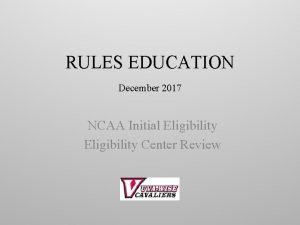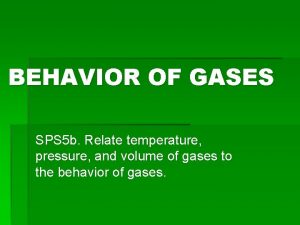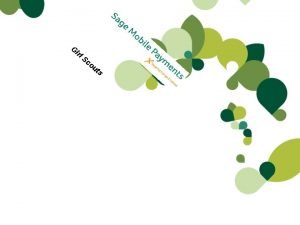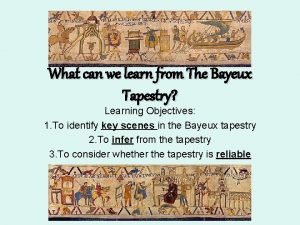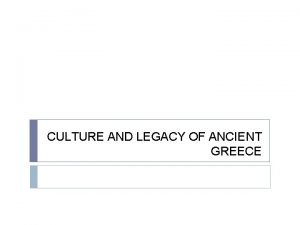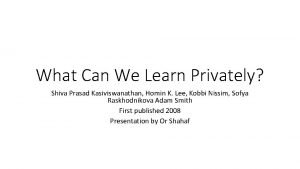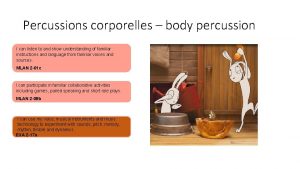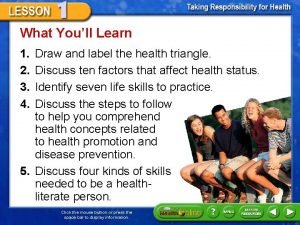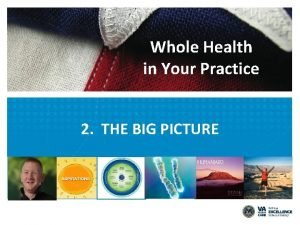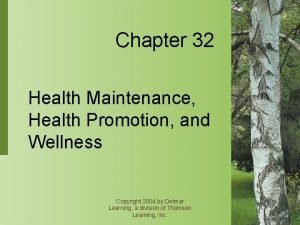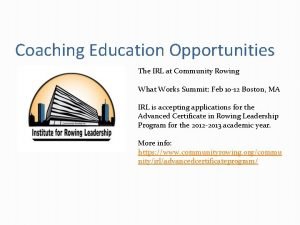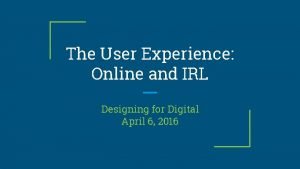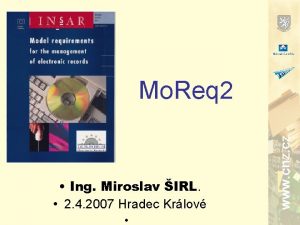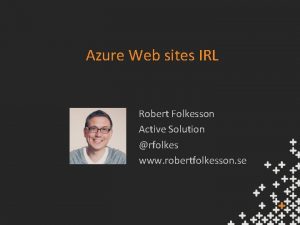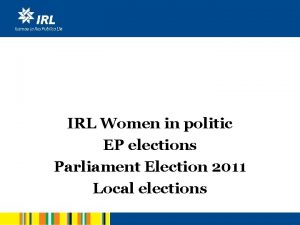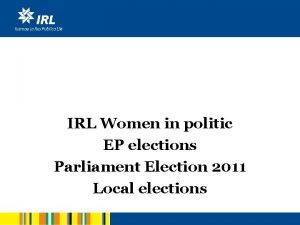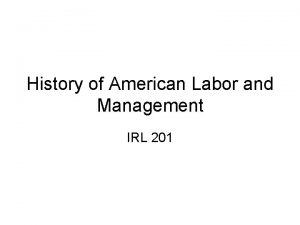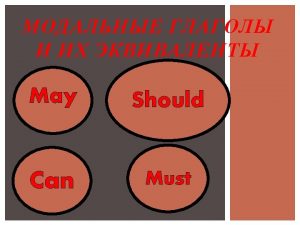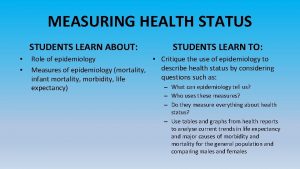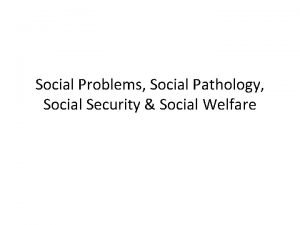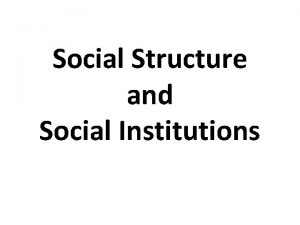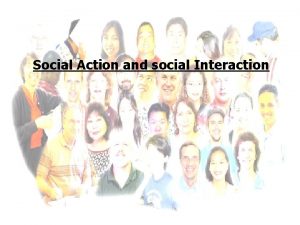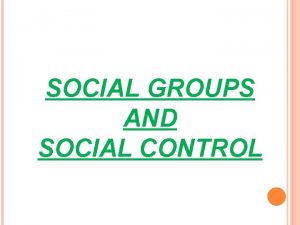Health IRL What can we learn from social




















































- Slides: 52

Health IRL What can we learn from social media? Urmimala Sarkar, MD, MPH Associate Professor University of California, San Francisco @Urmimala. Sarkar

Roadmap Brief introduction Rationale: social media research to solve public health problems Transdisciplinary collaboration Case Study: Online Physician Ratings Next steps


What we do Applied research = “aims at finding a solution for an immediate problem facing a society, or an industrial/business organization, whereas fundamental research is mainly concerned with generalizations and with the formulation of a theory” 1 I focus on evidence-based solutions for improving healthcare. 1 Kothari, C. R. (2008) “Research Methodology: Methods and Techniques” New Age International.

Areas of interest Health behaviors Patient safety Adverse medication events Missed and delayed diagnosis Health information technology Who uses it? Does it improve health or health behavior?

Advantages of using social media Provides immediate, real-time data Minimal observation bias Provides insights into health behaviors that are not usually shared in traditional methods of public health data collection “Behaviors that people might be reluctant to share with physicians are on full display on Twitter, including behaviors, opinions, and subpopulations that are otherwise difficult to track through traditional mechanisms, suggesting a whole new area of largescale public-health research. " (Dredze, 2012) Dredze M. How social media will change public health. IEEE Intelligent Systems. July-Aug 2012, 27(4): 81. 84.

Uses of social media for public health Promoting public health campaigns Reporting real-time infectious disease trends Recruitment of patients to online studies and clinical trials “Contagion” of behavior via social media Grajales FJ, Sheps S, Ho K, Novak-Lauscher H, Eysenbach G. Social Media: A Review and Tutorial of Applications in Medicine and Health Care. JMIR 2014 Feb 11; 16(2): e 13. Cameron, A. M. , Massie, A. B. , Alexander, C. E. , Stewart, B. , Montgomery, R. A. , Benavides, N. R. , Fleming, G. D. and Segev, D. L. (2013), Social Media and Organ Donor Registration: The Facebook Effect. American Journal of Transplantation, 13: 2059– 2065.

How can data from social media provide insight for public health? Observational studies using social media data sources Delivering cancer-relevant messages via online social media Online social media interventions for cancer prevention behaviors

1. Observational studies using social media data source Robust data source for behaviors that are difficult to characterize Complements health data that is unavailable through traditional surveillance Allows public health professionals to learn about public perceptions of prevention-relevant behaviors

1. Observational studies using social media data source Examples Substance use 1 Qualitative analysis showed various forms of opioid misuse on Twitter Body weight-associated stigma 2 Twitter and Facebook postings dominated by derogatory and misogynist sentiment, pointing to weight stigmatization Infectious disease surveillance 3 Using twitter messages to track influenza epidemic in real time 1 Chan B, Lopez A, Sarkar U. The Canary in the Coal Mine Tweets: Social Media Reveals Public Perceptions of Non-Medical Use of Opioids. PLo. S One. 2015; 10(8): e 0135072. 2 Chou WY, Prestin A, Kunath S. Obesity in social media: a mixed methods analysis. Translational behavioral medicine. 2014; 4(3): 314 -323. 3 Broniatowski DA, Paul MJ, Dredze M. National and local influenza surveillance through Twitter: an analysis of the 2012 -13 influenza epidemic. PLOS One 2013 Dec 9; 8(12) e 83672

1. Observational studies using social media data source Cervical cancer prevention discussions among young women on Twitter (Lyles, JCE, 2012)1 Women are willing to share publicly about their experiences with cervical cancer screening, encouraging peers to undergo screening as well User-generated health promotion messages useful for characterizing public sentiment and informing public health messaging content 1 Lyles CR, López A, Pasick R, Sarkar U. "5 mins of uncomfyness is better than dealing with cancer 4 a lifetime": an exploratory qualitative analysis of cervical and breast cancer screening dialogue on Twitter. J Cancer Educ. 2013 Mar; 28(1): 127 -33. doi: 10. 1007/s 13187 -012 -0432 -2.

Studying social media

2. Delivering cancerrelevant messages via online social media Social media = powerful advertising and marketing tool Example: Indoor tanning industry’s use of social media as a strategy for maintaining relationships with customers and to offer pricing deals that promote highfrequency tanning 1 1 Ricklefs CA, Asdigian NL, Kalra HL, et al. Indoor tanning promotions on social media in six US cities #UVTanning #tanning. Transl Behav Med. 2016; 6(2): 260270.

2. Delivering cancer-relevant messages via online social media Skin cancer prevention example: Google Ad. Words to display skin cancer prevention messages on individuals’ search results page when users searched for tanning beds Messages displayed 200, 000 times over 2 months Low-cost approach with significant reach 1 Cidre Serrano W, Chren MM, Resneck JS, Jr. , Aji NN, Pagoto S, Linos E. Online Advertising for Cancer Prevention: Google Ads and Tanning Beds. JAMA Dermatol. 2016; 152(1): 101 -102.

3. Online social media interventions for cancer prevention behaviors Social media = delivery platform for conducting intervention studies aimed at promoting health and wellness Applied research using social media We can harness the power of social media to solve public health problems Efficient and cost-effective approach to reaching people where they are

3. Online social media interventions for cancer prevention behaviors Example: The Tobacco Status Project (TSP) Facebook intervention for young adult smokers= messaging + peer-to-peer interaction + online counseling sessions + group cognitive-behavioral sessions 72% follow-up rates and 18% rate of reported 7 -day abstinence at 12 months (9% verified) High engagement with 92% participation over 3 months Results demonstrate that online social media platforms can be used to deliver behavioral interventions However, the content, mode of delivery, and network structure all require careful planning and evaluation

How transdisciplinary work happens: Case Study

What Patients Say About Their Doctors Online: A Qualitative Content Analysis Lopez A, Detz AL, Ratanawongsa NR, Sarkar U, Journal of General Internal Medicine, 2012 June 27(6): 685 -692

Online physician ratings Qualitative content analysis N=712 online review from two rating websites Purposive sample of 445 primary care doctors for 4 US urban regions (Atlanta, Chicago, NY, SF) Data source: ratemds. com and Yelp

Methods

Examples “Didn’t take me seriously when I knew something was wrong” “Really listens and doesn’t watch the clock” “Mis-prescribed a medicine I’ve been taking for years” “I don’t have time to waste I will not go back” “Makes embarrassing things not embarrassing”

Results

Results and Conclusions 63% positive reviews recommending doctors Global reviews vs. specific descriptions (e. g. , interpersonal manners) Specific reviews more positive than systemissues comments

Advancing the methodology using our data Paul MJ, Wallace BC, Dredze M. What Affects Patient (Dis) satisfaction? Analyzing Online Doctor Ratings with a Joint Topic-Sentiment Model. AAAI Workshop on Expanding the Boundaries of Health Informatics Using AI (HIAI); 2013. Main finding: using manually coded data compared to completely automated approaches performed better in identifying sentiment Next step: do online ratings have any association with any real-life health outcome of interest?

A large-scale quantitative analysis of latent factors and sentiment in online doctor reviews Wallace BC, Paul MJ, Sarkar U, Trikalinos TA, Dredze M. A large-scale quantitative analysis of latent factors and sentiment in online doctor reviews. J Am Med Inform Assoc. 2014 Nov-Dec; 21(6): 1098 -103. doi: 10. 1136/amiajnl-2014 -002711.

Methods Obtained data from Rate. MDs (http: //ratemds. com) Platform for patients to review doctors across four dimensions of care: helpful, knowledge, staff, and punctual Scored on a Likert scale of 1 (low) to 5 Sampled 58, 110 reviews of 19, 636 unique US doctors

Methods Analyzed a corpus of ~60 000 reviews Platform for patients to review doctors across four dimensions of care: helpful, knowledge, staff, and punctual Used state-of-the-art probabilistic model of text -- probabilistic generative model that captures latent sentiment across aspects of care (e. g. , interpersonal manner) Performed regression analysis to assess whether model output improves correlation with state-level measures of healthcare

Results

Results

Results Model output correlates with state-level measures of quality healthcare, including patient likelihood of visiting their primary care physician within 14 days of discharge (p=0. 03), and using the proposed model better predicts this outcome (p=0. 10) Similar results found for healthcare expenditures Main finding: Results showed that including f-LDA output in regression models improves correlations with state-level health outcome measures

Implications We each needed to conduct significant independent work before it could come together Potential of combining traditional qualitative analysis with large-scale quantitative modeling Ability to tie social media findings to real-world health outcomes requires collaboration Whole is greater than the sum of the parts

Opportunities for Collaboration Much untapped potential for using applying social media research to public health problems Demonstrated successful examples of transdisciplinary teamwork Data / computer scientist provide unique expertise to solving public problems

Thank you


Implications Social media has the potential to: Provide insights into the types of misuse of opioids Aid public health efforts to reduce non-medical opioid use

Results 375 (69%) tweets related to opioid behaviors 316 (84%) originated from individual user accounts 125 messages expressed personal experience with opioids Majority of personal messages referenced using opioids to obtain a "high", use for sleep, or other nonintended use

Influencing cervical cancer prevention and detection online through social media National Cancer Institute R 01 CA 178875 (Co-PIs: Sarkar & Centola)

Study Goal Use a mixed-methods approach to online social media and social networks for enhancing understanding of cervical cancer screening to optimize the spread of health messages and behaviors within online social networks

SNOWBALL Team Multi-disciplinary Team: Urmimala Sarkar, MD, MPH: Lead PI Damon Centola, Ph. D (UPenn): Co-PI, sociologist, social networking research Byron Wallace, Ph. D (Northeastern University): computer scientist, machine learning methods George Sawaya, MD (UCSF): obstetrics/gynecology, cervical cancer expertise Rena Pasick, Dr. PH (UCSF): behavioral and qualitative research Courtney Lyles, Ph. D (UCSF): health services research Gem Le, Ph. D, MHS (UCSF): project manager, social epidemiology, cancer prevention

Specific Aims Aim 1: To use machine learning techniques (i. e. , large-scale computer algorithms) to identify and rank the key words related to cervical cancer screening and HPV vaccination in social media messages. Aim 2: To categorize and validate the range of cervical cancer screening and HPV vaccination discussion on social media. Aim 3: To create cervical cancer screening and HPV vaccination messages for social media and evaluate their effectiveness for increasing diffusion through online social networks.

Cervical Cancer Epidemiology 12, 109 new cases of cervical cancer per year 1 Disparities by race/ ethnicity/ education 1 Hispanic women have highest rates Women with < high school education have lowest rates of screening 19% of adolescent girls (ages 12 -17) and 11% (ages 1827) initiated HPV vaccination in 20072 Ongoing need to bolster screening and prevention efforts 1 CDC, http: //www. cdc. gov/cancer/cervical/statistics/ 2 Tiro JA, Tsui J, Bauer HM, Yamada E, Kobrin S, Breen N. Journal of Women's Health. June 2012, 21(6): 656 -

Tweeting about Pap Smears “ 5 minutes of uncomfyness is better than cancer 4 a lifetime” “Guys encourage your mothers, sisters, wives girlfriends 13 to have regular pap smear. Also encourage them to get the vaccine. ” “Took the afternoon off so I could get a pap smear and my car could get an oil change. : -/” Lyles CR, Lopez A, Pasick R, Sarkar U. "5 mins of uncomfyness is better than dealing with cancer 4 a lifetime": an exploratory qualitative analysis of cervical and breast cancer screening dialogue on Twitter. Journal of Cancer Education. 2013; 28(1): 127 -33.

SNOWBALL Data & Methods Aim 1 work: 119, 428, 139 Twitter messages obtained from March 2014 (1% sample from all of Twitter) Filtered messages matching our keywords of interest (e. g. , pap smear, HPV, papillomavirus, pap test, cervical, cervix, cervical cancer, papanicolau, squamous, smear test, dysplasia) Applied Sparse Principal Components Analysis (SPCA) to identify clusters of keywords that are mathematically grouped into topics


Tweets for One Topic 1. CBC News HPV Vaccine Funding Cut by Canadian Province; poly. DNA Recommends that Canadian Doctors Learn About. . . http: //t. co/QSn 8 Urev 73 2. RT @gogreen 18: the anti-vaccine movement scares the crap out of me. i have paranoid family members now opting out of HPV vaccines for theiƒ_Ý 3. Study: HPV vaccine working - The Human Papillomavirus vaccine has reduced the frequency of abnormal Pap smears and…http: //t. co/X 7 b. F 0 I 8 s. YW 4. @positivegp is HPV vaccine only for girls/women? The lady mentioned genital warts on the penis as well, do men get vaccine? 5. Another Success for HPV Vaccine http: //t. co/DEgv. ZIYy. Fb 6. . @Cheryl. MHolmes on province set to stop funding HPV vaccine for some women: http: //t. co/QVEjwlp. SYB 7. RT @Cheryl. MHolmes: Manitoba to cut free HPV vaccine program for young women on April 1. Are you worried about getting your shots? 8. #googlenews One dose of HPV vaccine may prevent cervical cancer - New Straits Times http: //t. co/St. Yww 0 Cijl 9. RT @Rwanda_Post: Vaccine for Cervical Cancer Coming to Rwanda - http: //t. co/s. LWCpoq. WLe #Rwanda #RWo. T 10. @RTH 2039: BMJ Press Release: HPV vaccine provides significant protection against cervical abnormalities http: //t. co/t 1 n. WLu. IGz. P @Julie. Leask

Caveats in analyzing social media data Socio-demographic characteristics Subject to selection bias Twitter users more likely to be young and non-white Social media data viewed as MORE than “big data” Big data refer to very large datasets that can be analyzed or mined quantitatively to explore human behaviors and interactions Analysis of social media data need to incorporate mixed methods Should not rely on automated analysis alone (e. g. , machine learning methods) for meaning analysis and interpretation of the data

Next steps Identify impactful messages Classify manually Sample for experiment Expose women to messages on experimental network Outcomes of message contagion Behavioral expectations (do they now plan to get Pap smear or vaccination? )

: Social Media Perceptions of Non-Medical Use of Opioids Chan B, Lopez A, Sarkar U. The Canary in the Coal Mine Tweets: Social Media Reveals Public Perceptions of Non-Medical Use of Opioids. PLo. S One. 2015; 10(8): e 0135072.

Misuse of Opioids Non-medical prescription opioid use is a growing public health concern Prescriptions for opioid medications doubled between 1994 and 2007 Opioid prescription related deaths (14, 800) made up 73. 8% of the 20, 044 prescriptions drug overdose deaths in 2008 Social media can shed light on health attitudes, beliefs, and behaviors

Study Overview Exploratory, mixed-methods analysis of Twitter messages to characterize the nature of the content relating to opioid medications Described who uses social media to discuss opioid use or misuse, and what attitudes, themes, and behaviors social media users message about Hypothesis: Anonymity of social media allowed for more candid discussion of opioid misuse and abuse behaviors

Methods Cross-sectional sample of publicly available Twitter messages during a 2 week period in March and early April 2014 Manually searched Twitter messages using the following search terms: 1) Duragesic, 2) Fentanyl 3) Hydrocodone, 4) Hydros, 5) Oxy, 6) Oxycodone, 7) Oxycotin, 8) Oxycotton, 9) Vicodin, 10) Vikes, and 11) Oxycontin N = 540 tweets

Analysis Conducted content analysis to code each Twitter message Developed codes deductively using commonly accepted definitions of prescription drug abuse and aberrancy behaviors, an existing opioid misuse tool, the Current Opioid Misuse Measure (COMM) Developed codes inductively, through a grounded theory approach, as additional themes arose not captured by existing thematic coding schemes
 Gay lussac's law in real life
Gay lussac's law in real life Ncaa irl
Ncaa irl Trapezoid irl
Trapezoid irl Charles law real life application
Charles law real life application Irl uksw
Irl uksw Sage irl
Sage irl Kinetic learning
Kinetic learning Health and social care component 3 health and wellbeing
Health and social care component 3 health and wellbeing Woopmay orogeny
Woopmay orogeny Character traits of ants
Character traits of ants What can we learn from the passage
What can we learn from the passage What can we learn from the bayeux tapestry
What can we learn from the bayeux tapestry Culture or way of living station 1
Culture or way of living station 1 All children can learn slogan
All children can learn slogan What can we learn privately
What can we learn privately What can we learn from india
What can we learn from india Morse code ascii
Morse code ascii Social thinking and social influence in psychology
Social thinking and social influence in psychology Social thinking social influence social relations
Social thinking social influence social relations Udinus learn social
Udinus learn social If you can imagine it you can achieve it
If you can imagine it you can achieve it Kinds of comparison
Kinds of comparison If you think you can you can poem
If you think you can you can poem You can't improve what you don't measure quote
You can't improve what you don't measure quote If you cant measure it you can't manage it
If you cant measure it you can't manage it Percussions corporelles
Percussions corporelles Elements of curriculum
Elements of curriculum You can tell harris about it just ____(easily) as i can.
You can tell harris about it just ____(easily) as i can. Kinds of degree
Kinds of degree He can speak english
He can speak english Look at the pictures and complete with can or can't
Look at the pictures and complete with can or can't The jean
The jean Through you blind eyes are open
Through you blind eyes are open If you cannot measure it you cannot manage it
If you cannot measure it you cannot manage it Talk en futuro
Talk en futuro Any fool can write code that a computer can understand
Any fool can write code that a computer can understand Should i compare thee
Should i compare thee Goldene bilanzregel
Goldene bilanzregel Modal verbs can can't
Modal verbs can can't We can talk mental health training
We can talk mental health training With money you can buy clock but not time
With money you can buy clock but not time How can random events affect health status
How can random events affect health status Role and responsibility of occupational health nurse
Role and responsibility of occupational health nurse National programmes related to child health and welfare
National programmes related to child health and welfare Louisiana department of health health standards section
Louisiana department of health health standards section Difference between health education and promotion
Difference between health education and promotion Whole health circle of health
Whole health circle of health Health promotion world health organization
Health promotion world health organization Pcb 3703c ucf
Pcb 3703c ucf Chapter 3 health wellness and health disparities
Chapter 3 health wellness and health disparities Health propaganda definition
Health propaganda definition Chapter 1 understanding health and wellness lesson 2
Chapter 1 understanding health and wellness lesson 2 Chapter one understanding health and wellness
Chapter one understanding health and wellness

